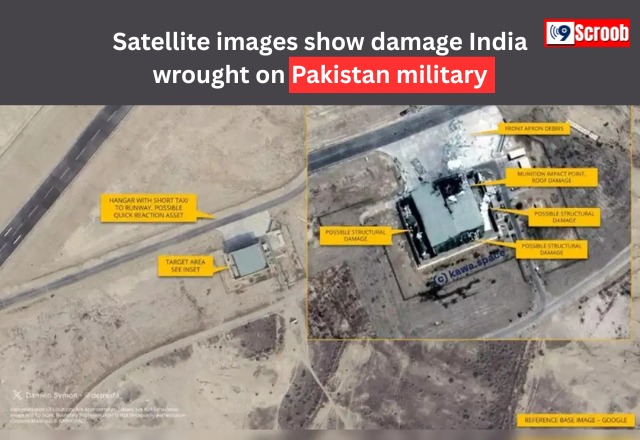India-Pakistan Tensions: Satellite Images
New satellite imagery released by India’s Defence Ministry and commercial intelligence providers has confirmed a series of precision strikes carried out by the Indian Armed Forces on May 10, targeting eight major Pakistani airbases. These airstrikes occurred just hours before both nations agreed to halt military actions.
According to officials familiar with the matter, India launched the strikes in retaliation after Pakistan attempted to hit 26 Indian military facilities earlier that same day. The Indian operation highlighted a significant technological and strategic advantage, showcasing the capability of its long-range precision strike systems.
Key Targets and Damage Assessment
Sialkot
Indian forces struck a terrorist launchpad in Sialkot, leading to significant destruction. Visuals showed thick smoke rising from the facility, signaling a direct and effective hit.
Nur Khan Airbase – Rawalpindi
At the Nur Khan airbase, satellite images revealed visible damage to an operations-related building and multiple military vehicles. Geo-intelligence researcher Damien Symon noted that vehicles were destroyed and the building compound suffered damage consistent with a precision strike.
Sargodha Airbase – Punjab
The runway at Sargodha was struck at two key points, likely disabling flight operations. Analysts believe take-offs and landings will remain suspended until significant repairs are completed.
Shahbaz Airbase – Jacobabad, Sindh
At Shahbaz airbase, a missile hit a hangar adjacent to the air traffic control tower. While the ATC tower itself remained structurally intact, the damage to the nearby facility suggests a calculated effort to impair operational readiness without risking civilian harm.
Rahim Yar Khan Airbase – Punjab
This base appeared to be the most heavily damaged. The runway was reportedly destroyed, with satellite imagery exposing deep structural disruption that may delay restoration for the long term.
Sukkur Airbase – Sindh
A UAV storage depot at Sukkur sustained considerable damage. The roof was breached, and debris was visible across the site, confirming a direct hit intended to degrade Pakistan’s drone capabilities.
Bholari Airbase – Southern Sindh
In Bholari, a military hangar—possibly used for airborne early warning systems—was severely damaged. Debris scattered around the facility suggests a serious structural failure following the strike.
Strategic Strikes on Radar Systems
In addition to targeting airbases, the Indian military appears to have conducted strikes on radar installations, which are believed to be linked to Pakistan’s early warning and surveillance systems. This move could significantly disrupt Pakistan Air Force’s ability to monitor and respond to airspace activity in the region.
Expert Insight
Geo-intelligence analyst Damien Symon from The Intel Lab commented on the precision of the strikes, stating that the operations were “intentionally designed to neutralize military infrastructure while avoiding collateral damage.” This approach reflects a high level of planning and technological superiority in India’s military strategy.
Conclusion
The recent precision strikes by India have not only demonstrated its ability to respond decisively but have also revealed key weaknesses in Pakistan’s military infrastructure. With multiple airbases and surveillance systems disrupted, the strikes are expected to have a lasting strategic impact on regional air defense dynamics.














